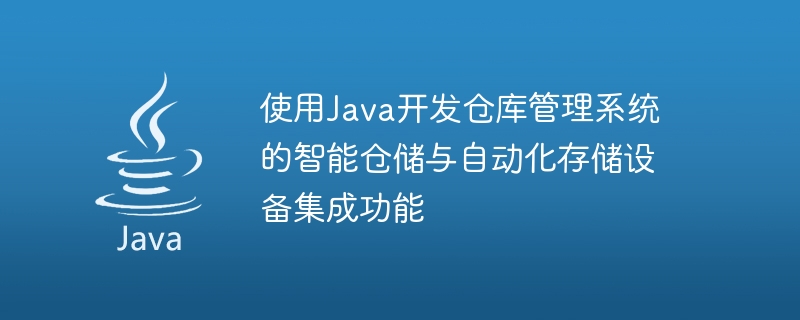

Title: Using Java to develop intelligent warehousing and automated storage equipment integration functions of warehouse management systems
Abstract:
With the development of the logistics industry, warehouse management systems It plays an important role in improving warehousing efficiency and reducing costs. In order to meet the growing logistics needs, developing a warehouse management system with the help of Java and integrating the functions of intelligent warehousing and automated storage equipment has become a solution worth considering. This article will explore how to use Java to develop a warehouse management system and give relevant code examples.
// 实现货物入库功能
public void inStock(String goodsId, int quantity) {
// 根据货物ID查询库存
int stock = inventoryDao.queryStock(goodsId);
// 更新库存
inventoryDao.updateStock(goodsId, stock + quantity);
}
// 实现货物出库功能
public void outStock(String goodsId, int quantity) {
// 根据货物ID查询库存
int stock = inventoryDao.queryStock(goodsId);
// 检查库存是否足够
if (stock < quantity) {
throw new RuntimeException("库存不足");
}
// 更新库存
inventoryDao.updateStock(goodsId, stock - quantity);
}
// 实现库位分配和释放功能
public String allocateLocation() {
// 查询可用的空闲库位
String location = locationDao.queryFreeLocation();
if (location == null) {
throw new RuntimeException("没有可用的库位");
}
// 将库位标记为已使用
locationDao.markLocationUsed(location);
return location;
}
public void releaseLocation(String location) {
// 将库位标记为空闲
locationDao.markLocationFree(location);
}
// 实现运输任务调度功能
public void scheduleTransportTask(String taskId, String fromLocation, String toLocation) {
// 调用物流设备接口,下发运输任务
logisticsDevice.scheduleTask(taskId, fromLocation, toLocation);
}// 实现自动化货架控制功能
public void moveShelf(String shelfId, String location) {
// 调用物联网设备接口,控制自动化货架移动到指定位置
IoTDevice.moveShelf(shelfId, location);
}
// 实现自动化堆垛机控制功能
public void moveStacker(String stackerId, String location) {
// 调用物联网设备接口,控制自动化堆垛机移动到指定位置
IoTDevice.moveStacker(stackerId, location);
}Conclusion:
This article introduces the basic steps of developing a warehouse management system using Java and gives relevant code examples. By integrating the functions of smart warehousing and automated storage equipment, warehouse management efficiency can be greatly improved and logistics costs reduced. With the development of the logistics industry, such warehouse management systems will play an increasingly important role in the future.
The above is the detailed content of Using Java to develop intelligent warehousing and automated storage equipment integration functions of warehouse management systems. For more information, please follow other related articles on the PHP Chinese website!
 Mechanical energy conservation law formula
Mechanical energy conservation law formula
 what is dandelion
what is dandelion
 The function of intermediate relay
The function of intermediate relay
 How to pay with WeChat on Douyin
How to pay with WeChat on Douyin
 All uses of cloud servers
All uses of cloud servers
 How to apply for a business email
How to apply for a business email
 Can Douyin short videos be restored after being deleted?
Can Douyin short videos be restored after being deleted?
 formatter function usage
formatter function usage
 How to use months_between in SQL
How to use months_between in SQL




